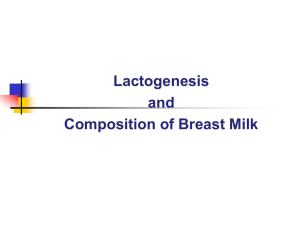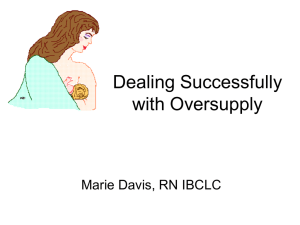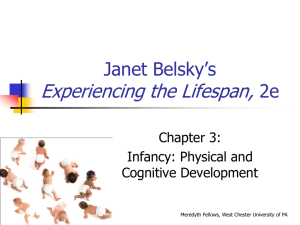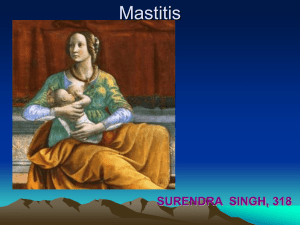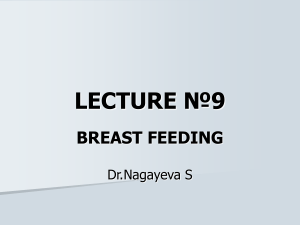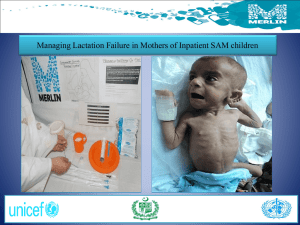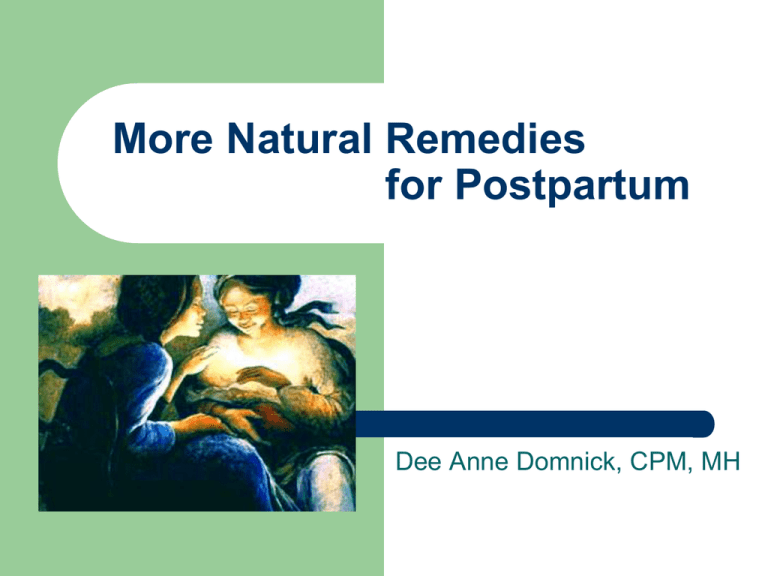
More Natural Remedies
for Postpartum
Dee Anne Domnick, CPM, MH
Yoni Healing
(Yoni is the Sanskrit word for women’s genitalia)
Torn bottoms can often well heal with herbs
rather than stitches.
Postpartum Sitz Bath I
This is an herbal combination used after birth to help soothe and heal the mother's
perineal/vaginal area, as well as to help heal baby's umbilical cord stump.
SHEPHERD'S PURSE - this herb is an amazing blood coagulant and vasoconstrictor. Arrests internal and external
bleeding after childbirth virtually immediately. High in oxytocin, it will help the uterus contract to clamp off blood
vessels. This herb is best in its fresh form, but for this application, dried is just fine.
COMFREY ROOT & LEAF - one of the best healing herbs of all time. It is not only soothing, but constrictive and
healing for wounds, cuts, and tears. It is a cell proliferant and promotes speedy wound healing both inside and out
and guards against scar tissue developing incorrectly. It is also very nourishing as it contains high amounts of
digestible plant calcium, iron, protein (up to seven times more protein than soybeans), B vitamins, Vitamin A, as
well as other nutrients necessary in rebuilding the body after childbirth. NOTE: If there is infection present, do not
use Comfrey as it may heal the outside so quickly that it may heal over infected tissues inside.
GARLIC - Herbal antibiotic. It is one of the most effective anti-microbial plants available, acting on bacteria, viruses
and funguses, as well as alimentary parasites. Stimulates, builds and supports the immune system. Garlic is also
helpful in increasing clotting time in the blood. One of the best herbs ever!
MYRRH - stimulates the production of white blood corpuscles which has a direct anti-microbial effect. It is
astringent, therefore it is very healing and antiseptic for any wound or abrasion. Relieves spasms, shrinks inflamed
tissue, reduces pain and encourages healing.
UVA URSI - kills bacteria in the bladder and will disinfect the urinary tract. One of the best herbs for bladder
infection, even those resistant to antibiotics and standard allopathic medicines. Helpful for vaginitis as well.
Although it is astringent and antibacterial, it will generally soothe, tone and strengthen the urinary system. (Also
known as Bearberry or Kinnikinnick.)
LAVENDER - one of the best calming and soothing herbs, not only for the body, but the mind as well, as it is quite
effective in alleviating depression. It has a special affinity for women's spirit. Good for all kinds of skin complaints,
from sunburn to vaginal discharge and anal fissures. Excellent for headaches, depression and nerves (both
physical and emotional!).
SAGE - astringent, antiseptic, anti-microbial and anti-inflammatory. Good for skin infections and vaginal discharge.
Promotes healing of wounds and is a uterine stimulator.
Postpartum Sitz Bath II
For tears & healing sore bottoms:
Comfrey root, ground
Shepherd’s Purse
Uva Ursi leaf
Sea Salt
Prepare as herbal tea except use 4 oz. tea to 1
gallon of water—Do not boil.
Strain and do sitz 2-4 times daily.
Bruised or Swollen Vulva
Icepacks or Icy Fingers
Homeopathic Arnica---orally
After Birth Pains
St. John’s Wort Oil, rubbed into the belly.
Cramp bark (Viburnum opulus)
Tincture or tea relieves ‘after-pains’ .
Hemorrhoids
Avoid constipation. Eat a diet high in fiber and whole grains. Eat plenty of
fresh fruit and vegetables. Drink 8 to 10 glasses of water a day.
Exercise, even if it is just a brisk 10-minute walk.
Sit on a pillow or inflatable ring.
Alternate between sitting and walking.
Apply chilled aloe/oatmeal compress, 3 or 4 times a day.
Place Witch Hazel (Hammamelis viriniana) compresses on your sanitary
napkin. --Witch Hazel is a natural astringent used to reduce swelling and
inflammation. It is effective in stopping the flow of blood, and in reducing secretions.
Cleanse your rectal area thoroughly after each bowel movement.
Air-dry your rectal area.
Warm herbal sitz bath 3 or 4 times a day.
Apply a topical spray to your hemorrhoids.
Apply ice or heat.
Do Kegel exercises.
Sore Nipples
Food grade lanolin (Lansinoh) can be applied to the nipple. This will help
protect and heal. It can be found in any drug store, and is safe for the baby to
nurse from.
Do not use soap on the nipples. The nipples exude an antibacterial substance
that will help keep the nipples clean naturally. Soap will interfere with this and
can dry out the nipples, causing further irritation.
Rub breastmilk onto nipples for extra anti-bacterial support.
Change breastpads often. Keep nipples clean and dry.
Expose the nipples and breasts to sunlight for brief periods to strengthen
tissues.
In extreme cases, use a nipple guard:
More Natural Remedies for
Sore Nipples
CAUTION: Ointments containing antibiotics, steroids and anesthetic (painkilling) drugs are potentially harmful to both mother and infant.
Crushed ice wrapped in a wet cloth, or a frozen gauze pad, applied to the nipples
immediately before nursing is a good local pain killer. This cold treatment also helps bring
out soft or small nipples and helps baby feed more easily when the breasts are very full.
Comfrey ointment softens and strengthens nipples at the same time. It is exceptionally
soothing to sensitive nipples and rapidly heals any fissures or bruises.
Yarrow leaf poultices - or yarrow infused oil - provide almost instantaneous pain relief
and heal cracked nipples rapidly.
Any of the poultices described for painful breasts may be used advantageously. Comfrey
and marshmallow are especially effective. Many brief poultices work better than one or
two lengthy sessions.
The gel from a fresh aloe vera leaf will soothe and heal sore and cracked nipples. Wash
off the aloe before the baby nurses to clear off the bitter taste of the aloe.
Calendula ointment is an old favorite to heal and strengthen nipples.
Main Causes of Painful Breasts:
Engorgement
A blocked milk tube or duct
Mastitis (infection in the breast)
Whether coping with a sore breast from a
plugged duct or a breast infection, the
initial care is similar:
Nurse frequently, rest and apply heat
to the tender area.
Engorgement
An oversupply of milk engorges the breast tissues, causing
tenderness and pain. There is no fever & breasts are not lumpy.
Engorgement may occur as a
result of:
–
–
–
–
a decision not to nurse
milk coming in very quickly
mother and child being
separated for an extended time
the process of weaning
Nurse frequently, rest
and apply heat to the
tender area.
A hot shower over the
breasts will aid the let-down
mechanism and relieve
engorgement.
If the mother is not going to be nursing due to a loss or because of weaning,
a classic remedy for stopping the flow of milk is to sip on a strong tea of
sage—up to three cups per day.
A Blocked Milk Tube or Duct
Swelling of the breast and
acute pain
May feel lumpy and bruised
Cessation of nursing can
increase the discomfort and
threaten the milk supply.
Nurse frequently, rest and
apply heat to the tender area.
Pump if you miss a feeding.
Right before nursing, use dry or
wet heat for 10 minutes.
Gently massage the sore area of
the breast before nursing.
Vary breastfeeding positions.
Echinacea will increase your
white blood cell activity (the
infection fighters) to prevent
infection.
Wear loose-fitting clothing
Plugged Ducts
Breastmilk is made up of a large amount of fat, which is necessary for the baby’s development and nutrition. In
some people, these fats can coagulate, or plug up in the duct. It’s kind of like a plugged up pipe in the breast
with milk backing up behind it. It can be very painful and if not attended to, can lead to mastitis (breast infection).
Several things can lead to a plugged duct, including missed feedings, constriction of the breast (such as a tight,
ill-fitting or underwire bra), or a high fat diet.
1. Pump if you miss a feeding. Try not to let the milk just sit in the breast for long periods of time.
2. Keep nursing! This is so important! It may be painful, but it’s necessary to keep that plug
moving out so that it doesn’t cause infection.
3. Apply heat. Heat will help “melt” the plug or soften it so that it will move out easily.
4. Massage the breast from behind the plug toward the nipple as the baby sucks to help move
the plug out. It is not a problem if the plug comes out in the baby’s mouth. One of my lactation
consultant associates describes that as the “ice cream”!
5. Position the baby while nursing so that his chin points to where the plug is. This has the most
drawing effect. Get help if you need it to position the baby. It may be breastfeeding acrobatics!
6. If chronic plugged ducts are a problem, you can take Lecithin on a regular basis. This is safe
for both you and the baby, even in larger doses. It comes in a granule or in a gelcap (like
Vitamin E). Take the dose that works for you. For me, it was 4 gelcaps in the morning and 4 at
night. I never got another plug again! Also, pay attention to your diet. Don’t eliminate fats
entirely, just go easy and eat a healthy diet as described above.
7. Take Poke Root and/or Echinacea. Poke Root is a lymph cleanser and will help clear the
breast tissue. Echinacea will increase your white blood cell activity (the infection fighters) to
prevent infection.
8. Do not wear a bra or any other garment that may constrict or block the breast or milk ducts.
Mastitis (infection in the breast)
Causes swelling and pain
May be fever
Acute tenderness and redness of the breast
The infected breast may be hard, lumpy and swollen
Mastitis is caused by several reasons, the most common are
plugged ducts that are not resolved, and by over-tired and stressed
moms who are not getting enough rest and who are doing too much.
Go to bed. Take your baby with you, nurse, and just rest. Get
someone to help take care of you, the baby and any household
chores that need attending to.
Keep nursing on the affected side. The milk from that breast is
still good and will not hurt the baby or make him sick. It is
important to keep nursing so that the infection doesn’t become
worse or so that your milk production doesn’t drop. If it does
decline, you can use galactagogue herbs to regain it.
Take Echinacea and Vitamin C. Both will stimulate and
strengthen your immune system.
Do not wear a bra or any garment that will constrict the breasts
or milk ducts.
Herbal Mastitis Treatments
Propolis is collected and used by bees as glue. It has a history
of use against infection in Russia and a strong following among
midwives in North America. It is said to accelerate healing time
by increasing the body's metabolism and general resistance to
disease. A dose of the tincture is 10 to 15 drops twice a day.
Echinacea root tincture is an excellent ally for any woman with
mastitis. Use one-half drop per pound of body weight as a single
dose. (For a woman who weighs 130 pounds, the dose is 65
drops or two dropperfuls.) The dose is repeated as often as
twelve times a day until symptoms remiss. Continue taking
Echinacea for at least a week after all symptoms have cleared.
Poke root (Phytolacca americana) tincture stimulates lymph
gland activity and clears mastitis quickly. Poke root is potent and
potentially toxic; the effect is cumulative. Use no more than two
drops of the tincture daily. Combine poke with Echinacea for
acute and severe infections.
Mastitis Pads
Breastwarmers
Price:$39.95
Prevention and relief of pain and discomfort associated with
mastitis, blocked milk ducts, engorgement and nipple vasospasm.
Also aids with letdown and expressing breastmilk.
A new way of applying an old remedy.
The Flectalon® Breastwarmer Mastitis Pads are made of a highly
efficient insulating material, which utilizes multilayered fibres and
reflective surfaces to reflect your natural body heat.
The warmth offers rapid relief and appears to work by helping the
milk flow more easily.
Simply place the slim, shaped pads inside your bra. Wear them as
often as needed - day and night if you like.
Thrush
thrush is caused by an
overgrowth of candida
albicans. It is a yeast
infection which mainly
affects babies.
Galactagogues help increase
breastmilk production
Fenugreek
The number one herb for breast health, breast enhancement and increasing milk
supply, fenugreek has been used to increase breast milk flow since biblical times. It
has always been a popular choice for both mothers and wet nurses. It quickly
increases milk flow and has many additional health benefits; balanced blood sugar,
cholesterol, hormone levels and breast tissue health.
Fennel
Fennel contains the same types of milk flow nutrients as fenugreek. It can also help
with high blood pressure, nausea and digestive problems. And it can be used in along
with fenugreek to expel gas and help soothe indigestion and colic.
Garlic
Monel Chemical Senses Center in Philadelphia found that when mothers took garlic
an hour before nursing, babies attached to the breast more readily, stayed longer and
drank more milk. And garlic, a natural anti-biotic, is used to prevent and treat mastitis,
a much healthier approach than the anti-biotic drugs commonly used to treat this.
More Herbs for Increasing Milk Flow:
Raspberry Leaf is high in vitamins and minerals and will also help the uterus to recover and
regain its size and shape quickly.
Alfalfa loaded with vitamins and minerals, including iron, calcium, and Vitamin K (the blood
coagulant vitamin).
Nettle loaded with vitamins and minerals, including iron, calcium, and Vitamin K.
Blessed Thistle is also used as a bitter and is extremely healthy for the liver.
Borage is an effective galactagogue, but isn’t an herb that one would want to use for longer
than a week at a time as it contains an alkaloid that may be harmful to the liver. It is a great
herb for cooling fevers and balancing the adrenals, and its beautiful purple flowers are edible
and are a lovely addition to any salad!
Hops has been used to increase mother’s milk (which is why they say to drink beer while
nursing), but can cause depression when used over an extended period of time. It may also
make you sleepy! The beer in other countries contains Hops that are helpful for milk production,
but much of the beer in the United States doesn’t seem to have the same content or quality.
Fussy Baby
First determine the
cause
–
–
–
–
–
Hungry
Wet diaper
In pain
Too hot or cold
Food reactions
Foods Known to Cause Colic
Beans
Cabbage, broccoli, brussels sprouts
Onions
Garlic
Dairy products
Caffeine
Chocolate
Natural Remedies for Colic
Identify offending food & avoid
“Burping”
Belly pressure
Try teas of:
–
–
–
Chamomile tea
Fennel
Anise
galactagogue
Helps stimulate milk production
Blue Vervain (Verbena off.)
Actions: Nervine tonic, anti-spasmodic, galactagogue, analgesic
50 - 75% women experience the
"baby blues" after giving birth.
Symptoms include:
–
–
–
–
crying for no apparent reason
impatience
irritability
restlessness and anxiety
Usually such feelings disappear
quickly and don't require treatment.
Postpartum Depression
10-15 % experience moderate to severe depression
Symptoms include:
Nervousness, anxiety, panic
Sluggishness, fatigue, exhaustion
Sadness, depression, hopelessness
Appetite and sleep disturbances
Poor concentration, confusion, memory loss
Over concern for the baby OR lack of interest in the baby
Uncontrollable crying, irritability
Guilt, inadequacy, worthlessness
Fear of harming the baby and/or yourself
Exaggerated highs and/or lows
Treatments for
Postpartum Depression
Communication of feelings
Relaxation techniques
Relief of physical discomforts
Uplifting teas or essential oils
Support groups
Educational programs
Home visits
Informal networks that support mothers
Hormone Therapy
Anti-depressants
Postpartum Blues Tea
Mix in equal parts:
Cramp Bark
Chamomile
Mugwort
Borage
Lavender
To Prepare:
–
–
Take 1 oz. herbs to 3 cups of water.
Bring to a boil and steep 15-30 minutes.
Dosage:
Drink ½ cup, 3 to 4 times daily.
Postpartum Psychosis
is the most severe but least common postpartum reaction.
Occurs in about 1 in 1000 new mothers.
Symptoms are exaggerated & severe and
may include:
–
–
–
–
Insomnia
Hallucinations
Agitation
Bizarre feelings or behavior.
Tooth Decay


